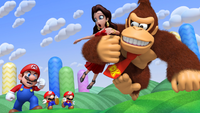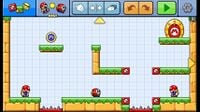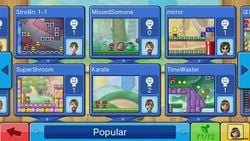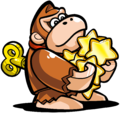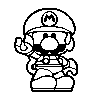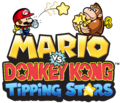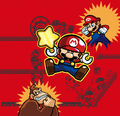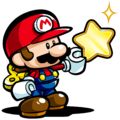Mario vs. Donkey Kong: Tipping Stars
| Mario vs. Donkey Kong: Tipping Stars | |||||||||
|---|---|---|---|---|---|---|---|---|---|
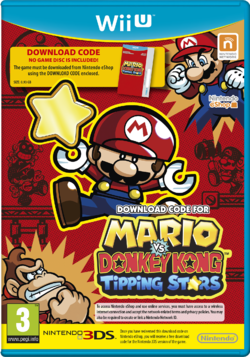 European Wii U box cover  European Nintendo 3DS box cover For alternate box art, see the game's gallery. | |||||||||
| Developer | Nintendo Software Technology Corporation Nintendo SPD Group No.3 | ||||||||
| Publisher | Nintendo | ||||||||
| Platform(s) | Wii U Nintendo 3DS | ||||||||
| Release date | |||||||||
| Genre | Puzzle | ||||||||
| Rating(s) |
| ||||||||
| Mode(s) | Single-player | ||||||||
| Media | Wii U: Nintendo 3DS: | ||||||||
| Input | Wii U: Nintendo 3DS:
| ||||||||
Mario vs. Donkey Kong: Tipping Stars is an action puzzle game for the Wii U and Nintendo 3DS. It is the sixth Mario vs. Donkey Kong game overall and the first game in the series to be released on a home console. The game is a follow-up to Mario vs. Donkey Kong: Mini-Land Mayhem! and shares elements with most of the series, including navigating a number of Minis to their exits and allowing players to build their own levels. Players were able to share custom stages through Miiverse until it was shut down on November 7, 2017. The title could also be played over Nintendo Network, but the service was terminated on April 8, 2024, making the game no longer playable online.[1][2] The focus of the game are the stars, which form a reward earned in accordance to how the player performs in levels. They are used to tip other players for their shared stages or unlock parts and new Minis for custom levels in the Workshop Store. The game is digital-only except in Japan. Game cases with download codes are sold in Europe. The Wii U version requires 0.93 GB of memory to be installed, and the Nintendo 3DS version requires 3,200 blocks[3] (409.6 MB).
The game supports a form of cross-platform play, where if one version of the game is bought off the Nintendo eShop, the buyer receives a free download code of the other version, and levels can be shared between the Nintendo 3DS and Wii U versions of the game.
The game was later removed from the Wii U and 3DS eShop services after their discontinuation on March 27, 2023, making it no longer possible for players outside of Japan to purchase the game, but players who did so before this date can still play it as long as any version is on their Wii U device, their 3DS device, or both.
Story[edit]
As in previous Mario vs. Donkey Kong games, Pauline is once again kidnapped by Donkey Kong, although this time, no motivation is given. Mario chases after Donkey Kong with his Mini Mario toys to rescue her.
After traversing six puzzle-filled worlds, while freeing cursed Mini Mario toys along the way, Mario catches up to Donkey Kong and Pauline in a darkened room. The lights are switched on, revealing Pauline, Donkey Kong, and two Toads giving Mario a surprise party. Mario can then continue through more worlds and bonus levels knowing Pauline is safe.
Gameplay[edit]
As in the game's predecessors, the main goal of every stage is to simply lead all Mini toys to the end of the level, which is done by manipulating certain parts of the environment. Using the console's touchscreen, players are able to drag objects such as red girders, springs, conveyor belts, pipes, and lifts to guide the characters.
The most common level type in the game is the Single-Door level, in which a lone Goal Door represents the objective. In order to clear a course, each Mini must be brought to the Goal Door, immediately followed by another. The first Mini toy to reach the exit commences a short timer which shuts the door after a few moments, locking away any other Mini toy if they do not reach the door in time and resulting in a Game Over. Multi-Door levels, a feature introduced in Mario vs. Donkey Kong: Mini-Land Mayhem!, are also found in Tipping Stars, where different Minis have to be rescued from Capsules and led through separate doors, each assigned to one of the Minis. In Multi-Door levels, there is no time limit between entering different doors.
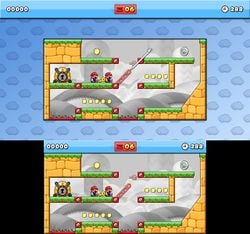
Each world contains eight levels and follows a specific formula:
- the first level of every world introduces a new game mechanic, which becomes recurrent from that point onward.
- the third level and, sometimes, sixth level is where enemies that cause damage, like Shy Guys, Pokeys or Thwomps, appear.
- the fourth level is always a Multi-Door course, the rest being Single-Door.
- the fifth level is marked by the presence of a type of Donkey Kong's robot, such as Circus Kongs, Cannon Kongs or Capture Kongs.
- the seventh level has a locked exit, which can only be opened by a Key Mini Mario.
- instead of a boss battle as in the predecessors, every world is closed by a level where a Cursed Mini Mario has to be reverted to its normal state by hitting it with Hammers, then escorted along with the other Minis to the Goal Door.
A level must be finished within its time limit, always set to 300 seconds. Otherwise, the result will be a Game Over. Other causes of a Game Over include falling on spikes, falling from a height of ten blocks or more, failing to enter the Goal Door before it closes, and coming into contact with an enemy such as a Shy Guy or a Pokey.[4] The only possibility to combat these enemies is by using Hammers, which are acquired for a short time and function similarly to the hammer from the Donkey Kong arcade game.
When there are only 30 seconds left in the timer, a frantic melody starts playing, prompting the player to hurry and finish the level. The music is the same as in the third installment, but remixed.
Scoring system and stars[edit]
Each level has a trophy ranking based on a score, which is determined by the following:
- Small and big coins spread throughout the levels. They are worth 100 and 1000 points, respectively. There is also a single M Coin in each level, worth 2000 points. Collecting all coins in a level awards the player an additional 6000 points.
- Every second left on the timer, each worth 20 points.
Three high scores signifying three different rankings are established for each level and are linked to a bronze, silver, and gold trophy, in order from lowest to highest. Acquiring one trophy rewards the player with one star; in this respect, achieving the gold trophy in a level signifies a three star rating for that level. Stars form a collectable entity, and a total of 267 stars can be earned in the main game. Before Miiverse was shut down, additional ones could also be obtained as tips from other players for uploaded levels.
Workshop[edit]
- Main article: Construction Zone § Mario vs. Donkey Kong: Tipping Stars
The game also features a mode known as the Workshop, which allows the player to create, play, and share their own custom levels. The Workshop Store allows players to use their collected stars to unlock elements that can be used in the level editor, which is known as the Workshop Editor.
Community[edit]
The game presented online functions, which were paired with Miiverse. However, as of November 7, 2017, when the service was shut down, these are no longer available. Before the discontinuation, levels made and shared by other players could be accessed in Community mode. People could play and 'Yeah' these levels. Stars earned in the main game or by playing user-created levels could be tipped to level creators, which unlocked Miiverse stamps for the tippers in exchange. Levels could be sorted by "Popular", "Latest", "Saved" (there was a download feature), "Friends & Followed", "Official Levels", and "Street Pass".
Both the Workshop mode and the Community mode are based on a user profile that was activated when users first entered either of them. Players without a profile have currently no access to the Community, but those who had opened a profile prior to the dicontinuation of Miiverse can still enter it, although it is devoid of levels. Players can click their Mii icon to access their own user profile, which displays some information linked to the service: the number of 'Yeah's received on their levels, comments posted, and stars tipped to other players, as well as the number of shared levels. Likewise, the SpotPass functionality can be toggled there. The profiles of other players could be accessed in Community mode via comments they had posted on other levels. Their region determined the color behind their Mii on the profile picture, which was red for Japan, yellow for Europe and Oceania, and blue for the Americas.
Help Mode[edit]
The game offers in-game tips for gameplay, editing and online features. However, they are handled differently depending on the version they appear in. In the Wii U version, tips simply appear on the loading screens. In the Nintendo 3DS version, there is a separate "Help Mode" accessible through a button with a question mark in each of the Game, Bonus, Workshop and Community menus.
In the main Game and Bonus menus, tips are related to gameplay. They are the following:
| Chain Rule: Minis must reach the goal close together, otherwise the M Door will shut and lock the others out. British English version: Minis must reach the goal close together; otherwise the door will shut and lock the others out. |
| Items: Items like Red Girders can be placed, picked up, and placed again. |
| Scrolling Controls [Nintendo 3DS version]: On large levels, use Scrolling Controls [Wii U version]: On large levels, use the Left Stick or the Right Stick to scroll around the screen. |
| Earning Gold Trophies: Pick up all the coins and reach the door quickly to earn a high score and a gold trophy. |
In the Workshop menu, tips are related to building levels and sharing them:
| Earning Tips: Share your level to earn stars! Online levels will earn stars when they are played. They can also earn stars when players tip you. |
| Resource Item Limits: Your level can contain up to four replaceable types of items, such as Red Girders, Long Springs, Movable Pipes or Blue Lifts. |
| Getting Ready To Share: Before you can share a level, you'll need to play through it and collect all the coins. |
| Level Themes: When editing a level, you can change the appearance of items in the background. |
Finally, the Community menu offered tips related to users found online and the interaction with them:
| Profiles: Access a player's profile by selecting their Mii from the comments list. |
| Tipping Good Levels: Tip the creator of a level with stars to let them know how much you like it. You can earn stamps in the process. |
| Location Colors: Check a Mii character's background color to see where the post came from. |
| Earning Stars: You can earn up to three stars on a level - one for each trophy. |
Controls[edit]
 – drag or tap objects; navigate menus
– drag or tap objects; navigate menus/
– navigate level
/
 – pause game
– pause game
Characters[edit]
The cast is primarily composed of the Mini toys, which are the focus of the Mario vs. Donkey Kong series. Mini Luigi appears for the first time, and Mini Donkey Kong receives a redesign. Despite Mario and Donkey Kong being titular characters, they fulfill only minor roles, appearing only on the title screen and the game's few cutscenes. In addition, Mario can be heard exclaiming "Way to go!" after all coins are collected in a level. Pauline and a few Toads also make appearances in the cutscenes.
The Minis do not behave differently from each other. They all simply walk from side to side, interacting with the environment at times. The only Mini that does, however, differentiate from the others is the Cursed Mini Mario, which is a possessed Mini Mario that smashes any other Mini on contact. It can be turned back to a normal Mini Mario if hit with Hammers, a slope slide, or via a Cannon blast.
Worlds[edit]
Each of the eight main worlds of the game (six standard, two extra) introduces a new mechanic and contains eight levels. The last level in each world is always centered around a Cursed Mini Mario. Levels in the main game are unlocked by completing the level that precede them.
Apart from the main game, there are 24 additional levels to unlock in a separate, Bonus feature. The player unlocks a Bonus Level for every 4 gold trophies obtained, except for Level B-21 onward, when levels are unlocked for each gold trophy earned. In order to unlock all Bonus Levels, the player has to acquire a total of 87 gold trophies. Compared to levels from the main game, Bonus Levels have increased difficulty. Each world from the main game is the setting of two consecutive Bonus Levels.
Between the Nintendo 3DS and the Wii U versions of the game, many levels have slight design differences to accommodate to the screen of the console. However, they only minimally affect gameplay in some of them.
| Main worlds | |
|---|---|
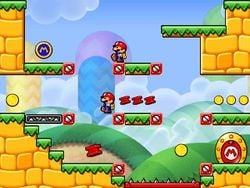
|
World 1 Rolling Hills Introduces the simple mechanics used throughout the game, such as Red Girders, Rivets and Ladders. Except for Cursed Mini Mario at the end, only a single Shy Guy and two Circus Kongs are present as enemies. Levels 1-1 • 1-2 • 1-3 • 1-4 • 1-5 • 1-6 • 1-7 • 1-8 |
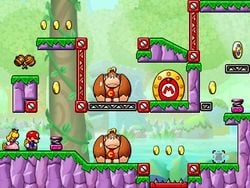
|
World 2 Jumpy Jungle A world that focuses on the use of Long and High Springs. Circus Kongs are also present here. Levels 2-1 • 2-2 • 2-3 • 2-4 • 2-5 • 2-6 • 2-7 • 2-8 |

|
World 3 Runaway Warehouse The emphasis of this world are the conveyors, many of which are purple and can be stretched between rivets. There are enemies as well, such as Thwomps and Cannon Kongs. Levels 3-1 • 3-2 • 3-3 • 3-4 • 3-5 • 3-6 • 3-7 • 3-8 |
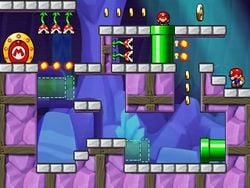
|
World 4 Crumbling Cavern A place teeming with Movable Pipes, green pipes which can be positioned conveniently. A few Fire Piranha Plants inhabit this world. Levels 4-1 • 4-2 • 4-3 • 4-4 • 4-5 • 4-6 • 4-7 • 4-8 |
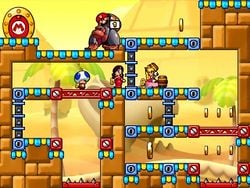
|
World 5 Dashing Desert This world introduces Blue Lifts and also marks the first appearance of Pokeys and Capture Kongs in the game. Levels 5-1 • 5-2 • 5-3 • 5-4 • 5-5 • 5-6 • 5-7 • 5-8 |
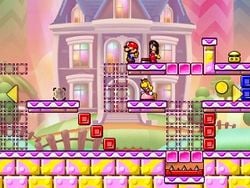
|
World 6 Twilight Valley The last world before the game's conclusion. It adds Pink Blocks to the gameplay, which act as solid walls and platforms and can be placed or removed. Levels 6-1 • 6-2 • 6-3 • 6-4 • 6-5 • 6-6 • 6-7 • 6-8 |
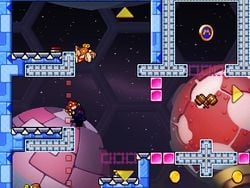 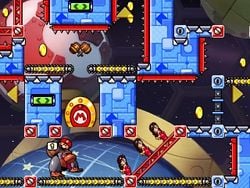
|
Worlds E1 and E2 Orbiting Observatory Two extra worlds in the main game, in which magnet surfaces are first explored. Many other elements introduced in previous worlds also appear. Levels E1-1 • E1-2 • E1-3 • E1-4 • E1-5 • E1-6 • E1-7 • E1-8 E2-1 • E2-2 • E2-3 • E2-4 • E2-5 • E2-6 • E2-7 • E2-8 |
| Bonus Levels | |||
|---|---|---|---|
| Bonus 1 Levels B-1 • B-2 • B-3 • B-4 • B-5 • B-6 • B-7 • B-8 | |||
| Bonus 2 Levels B-9 • B-10 • B-11 • B-12 • B-13 • B-14 • B-15 • B-16 | |||
| Bonus 3 Levels B-17 • B-18 • B-19 • B-20 • B-21 • B-22 • B-23 • B-24 | |||
Other areas[edit]
There are four unlockable backgrounds in the Workshop Store that can be used by players to decorate levels created by them in the editor. Although these areas do not have their own worlds in the main game, they theme some of the Bonus Levels. In the Workshop, there is an additional Editor Land theme, which is available to use from the start; however, none of the pre-built levels feature it.
| Winding Ravine is a sky area with rocky peaks and crags seen in the far background. Many huge, colorful mushrooms are grown above the clouds. Winding Ravine is set at dusk, as there are many stars visible in the sky. | 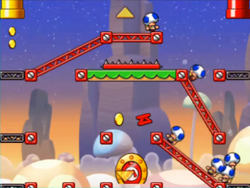
|
| Swirling Courtyard is an area located closely to Peach's Castle. Numerous arches with crenels surrounding the foreground are patterned with stars, as well as some heraldic banners containing Golden Mushroom badges. Further behind, beyond a shrub garden where several white pigeons fly around, lie the castle ramparts, with an opening visible. On a hill continuing even further and behind some towers is Princess Peach's Castle itself. The music that plays in Swirling Courtyard is reused from Teatime Twirl in Mario vs. Donkey Kong: Mini-Land Mayhem!. | 
|
| Clattering Cabin is a sinister and gloomy building with large Gothic windows and architecture. Many torches are placed on the walls, and there is a lot of old furniture as well. The area features two staircases leading to a big corridor. Next to the staircases is a grandfather clock with a pendulum resembling a Shy Guy mask, and under the staircases, the portrait of a Shy Guy. The music that plays in Clattering Cabin is a retuned version of Warped Mansion's music from Mario vs. Donkey Kong: Mini-Land Mayhem!. | 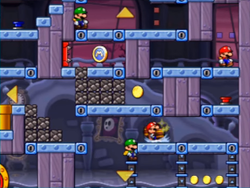
|
| Shimmering Gold Palace, or simply Gold Palace[5], is an area with piles of treasure gathered around a gilded palace. Structures present around the main building include towers and ramparts with many windows. The music that plays in Shimmering Gold Palace levels is an arrangement of the invincibility theme from the Super Mario franchise, which is also used for the Mini Guide in Mario vs. Donkey Kong: Mini-Land Mayhem!.
This area only decorates Level B-24. |
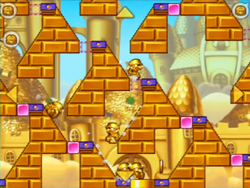
|
| Editor Land is an area that resembles the editing space in the Workshop, having a grid background. This is the only Workshop background not to decorate any pre-loaded levels from the game. | 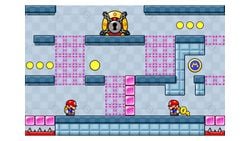
|
Objects[edit]
The game's numerous objects can be split into three categories: collectibles, objects that can be obtained only by a Mini toy; resource items, which can be stockpiled and moved or dragged on the screen using the console's touchscreen; and fixed objects, which cannot usually be modified but can be manipulated to help the Minis advance through a stage.
| Collectibles | |
|---|---|
| Item | About |
Coins |
Items found in every level, usually arranged in rows of three or more. Each awards the player 100 points for the score. Among these coins, there is also a large variety that is worth ten normal coins and, therefore, 1000 points. The player needs to collect all coins in a level in order to achieve three stars for that level. |
Hammers |
A pair of weapons that can be used by the Minis to combat enemies or destroy rocks. They are acquired for a short time and are banged repeatedly on the ground, confering the Mini that wields them a short period of invincibility. After they disappear, Hammers respawn in their initial position, allowing another use. If a Mini comes into contact with a Ladder or a Blue Lift while the Hammers are in use, they will be thrown high up in the air and can be picked up again if the Mini reaches the end of these objects in time. |
M Coin |
A special "M"-stamped coin that is worth 2000 points. Only one appears in every stage. Like the other types of coins, collecting the M Coin is mandatory to obtain a three-star rating in a level. |
Pickups |
Collectibles that increase the amount of resource items the player has, such as Girders, Blue Lifts and Purple Conveyors. However, they cannot be grabbed with the stylus; Minis are required to walk into them instead. |
| Resource items | |
| Item | About |
 Blue Lift |
A vertical succession of platforms that can be built between two blue rivets, only if one is located directly above the other. The movement of the platforms in a Blue Lift is determined by the direction of the swipe that created the Blue Lift. Upon encountering a Blue Lift, Minis will stop walking and will take the lift in the direction it moves, helping them reach platforms that are located underneath or above. |
High Spring and Long Spring |
Trampolines that help the Minis bounce to higher areas. High Springs are magenta and have an oblong shape—they launch the Minis on a vertical arc. Long Springs are yellow, rounded, and launch the Minis on a more widened arc. |
 Movable Pipes |
A pair of separate pipes that are somehow interconnected. When a Mini enters one pipe, it will be warped onto the other. The player can change the positions of these pipes to facilitate movement throughout an area, even though they can only be placed on predetermined slots. |
 Pink Block |
A block that can be picked up with the stylus and then used to fill a special slot by tapping on it. Pink Blocks come in formations, and act as platforms or walls to guide the Minis. |
 Purple Conveyor |
A platform that can be dragged across purple rivets. It moves automatically in the direction established by the player with the stylus. Apart from transporting the Minis, Purple Conveyors also turn them back if they are in opposing directions, without the need of a wall. |
Red Girder |
A platform that can be created by connecting two rivets of the corresponding color. The main game only contains red Girders, but the Workshop mode allows the player to use Girders of different colors, associated with a playable character (green—Mini Luigi, blue and white—Mini Toad, pink—Mini Peach etc.) If Red Girders are positioned horizontally or slightly slanting, the Minis can walk on them as on normal platforms. If their slant is too abrupt, they cause the Minis to slide on them as on a slope. If they are positioned vertically, they act as walls that prevent the Minis from walking further. Red Girders can be passed from underneath, making them semisolid. |
| Fixed objects | |
| Item | About |
 Cannon |
An object that slowly changes launching direction by rotating in place. It can store any amount of Minis that end up inside it, and can be tapped on to blast all Minis in the current direction. This way, apart from being able to reach far areas, the Minis can also zoom into rocks and enemies to destroy them. |
 Color Switches |
Red, blue, and yellow switches that enable or disable blocks of the same colors when jumped on. |
Conveyor |
A platform that conveys the Minis in the direction indicated by its arrows. Conveyors are always horizontal. |
Girder |
A semisolid platform that the Minis can walk on. Girders are always horizontal. |
 Goal Door |
The exit of each stage in the game. In Single-Door levels, the goal is to get all Minis into a single door. Once a Mini enters the door, the other have a short amount of time to reach it before it locks them away. A few levels feature locked exits, which require a Key Mini Mario to unlock. In Multi-Door levels, each character must be guided to the door that displays its face on it. |
Ladder |
A vertical set of steps needed to climb up to raised platforms, or go down a lower level. They can be seen as stationary Blue Lifts. Minis grab on a Ladder as soon as they walk into it, then continue to walk in the direction they previously followed. When two Minis bump into each other on a Ladder, they both change directions. |
  Magnet Ground |
A platform that allows the Minis to walk on all of its surfaces. Minis fall off a Magnet if they are hanging upside-down and encounter a non-magnetic surface on their way. |
Rock |
A small fragile block that breaks when hit with Hammers, a slope slide or a Cannon blast. Otherwise, rocks act as normal platforms the Minis can walk onto. |
Spikes |
Dangerous surfaces covering walls and platforms. Touching one such surface destroys the Mini. Spikes cannot be destroyed. |
  Pipes |
Warp Pipes come in two variations. Some Pipes are found in one piece, while others, also known as Split Pipes, have their ends separated from each other, and are also color-coded to acknowledge the player which pipe is connected to the other. Both types help transport the Minis to different locations in a level, although the length of blue Warp Pipes affect how long the Minis take to reach the other end, while Split Pipes have considerably less delay. |
Enemies[edit]
Enemies in the game can be divided into two categories, based on how they affect the player. Donkey Kong's robots are rather large and indestructible but do not cause damage, and in some situations their capacities are helpful; however, they can also often impede the player, in which case Hammers are available to stun them temporarily. Aside from Donkey Kong's robots, there are harmful enemies that only serve as obstacles and can usually be destroyed with Hammers or other means of attack. Cannon Kongs also appear for the first time.
| Donkey Kong's robots | |||
|---|---|---|---|
| Enemy | About | First appearance | Last appearance |
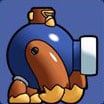 Cannon Kong |
A stationary toy whose body consists of a giant cannon. When a Mini enters a Cannon Kong, it gets immediately launched in the direction the enemy is currently facing. This can help traverse unskippable distances and, sometimes, crash through Rocks. | Level 3-5 | Level E2-7 |
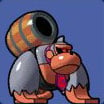 Capture Kong |
A wandering toy that is equipped with a small barrel on its back, which it uses to capture and disable any Mini that walks into it. Hitting a Capture Kong with Hammers will stun it and free all captured Minis. While not lethal, Capture Kongs can cause a Game Over if they capture all Minis in a level. In some cases, Capture Kongs are used to the Minis' advantage, as they are able to travel on spikes and thus ferry the Minis to a safe spot. | Level 5-5 | Level E2-5 |
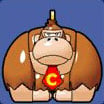 Circus Kong |
A toy that tosses Minis upward repeatedly, as if juggling. Minis can escape a Circus Kong if a surface is placed between them, or if the Kong is stunned with Hammers. | Level 1-5 | Level E1-5 |
| Enemies that cause damage | |||
| Enemy | About | First appearance | Last appearance |
Fire Piranha Plant |
A stationary enemy that is stuck to a surface. Apart from being harmful to touch directly, it attacks by spitting a single fireball, which travels in a straight line and returns into the enemy's mouth after bouncing off any opposing surface. The fireball can be blocked from re-entering the plant's mouth if a surface is placed in-between. A sliding attack or a pair of Hammers is necessary to destroy Fire Piranha Plants. | Level 4-3 | Level E2-3 |
Piranha Plant |
An enemy that, much the same as the Fire Piranha Plants, is always fixed to a surface, injuring any Mini that touches it. However, it lacks the ability to create fireballs, but can keep the fireballs of Fire Piranha Plants in its mouth and spit them as well. Piranha Plants can be destroyed by hitting them with Hammers or by sliding into them. | Level 5-6 | Level 6-8 |
 Pokey |
A tall, spiky, three-segmented enemy that simply roams back and forth on a platform, with no active intent to hurt the Minis, despite being harmful to touch. Pokeys can be defeated with Hammers, by sliding into them, or by blasting into them from a cannon. | Level 5-3 | Level E1-3 |
 Shy Guy |
A stout enemy that walks from side to side, destroying a Mini if it comes into direct contact. Shy Guys can be defeated by using Hammers, by sliding into them, or shooting into them from a cannon. | Level 1-3 | Level E2-7 |
 Thwomp |
A floating stone enemy that comes crashing on the ground when walked directly under, even though it can notice the Minis from a few spaces afar. It signals its attack by shaking in place for roughly four seconds, then plummets forcefully on the ground, squashing any Mini walking beneath it. Thwomps are completely invincible. | Level 3-3 | Level E2-7 |
Stamps[edit]
- Main article: List of Mario vs. Donkey Kong: Tipping Stars stamps
Like some other Wii U games, this game features stamps. One way of getting those is by buying items in the Workshop Store. 84 stamps can be collected.[6]
Technical aspects[edit]
The Wii U version is designed to be controlled through and on the GamePad's touch screen alone. A secondary screen view is shown on the TV, but with large borders around its view area.
The sound is in stereo, with no support for 5.1 surround on Wii U.
Update history[edit]
1.0.1[edit]
The Nintendo 3DS version of the game was updated on September 1, 2015. The update prevented players from posting certain levels that caused errors in the Community mode.[7][8]
Nintendo 3DS eShop description[edit]
- American English version
Get that 'aha!' feeling over and over as you guide Minis—toy versions of Nintendo characters—to the exit in each puzzling stage. Tap objects—like bridges and springs—with the stylus to perfect your strategy. You can create stages and play them however you want, unlocking even more content and experiences the more you play! Donkey Kong's rivalry with Mario™ reignites in an all-out puzzle challenge! Tackle more than 80 tricky stages filled with clever puzzles and tough obstacles: girders, spiked floors, wind-up enemies, warp pipes, conveyer belts and more! Plus you can make your own levels, so there's no end to the fun. As you beat levels, you earn stars that can be cashed in to earn new parts for level creation. The more you play, the more you can make!
- British English version
Uh-oh! Donkey Kong's kidnapped Pauline, and only Mario can rescue her in puzzler Mario vs. Donkey Kong: Tipping Stars! Guide mini, clockwork versions of Mario and friends to the exits in over 60 increasingly-fiendish 2D puzzle stages! Build and share your own levels, or download new ones from other players. If you find a stage you like, you can even tip the creator with stars, giving them the chance to build even better stages in the future!
Development and release[edit]
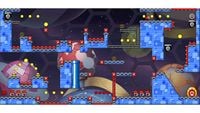
Before the game was revealed to be a full release title, several early levels were presented in the form of a tech demo at Game Developers Conference on March 2014. The demo was used to showcase the Nintendo Web Framework, a developer toolset used to program software onto the console with web compatible technologies like HTML and JavaScript.[9] The demo contained the following levels:[10]
- Level D-1, which would be shipped with the release version as Level 1-1.
- Level D-2, which would be shipped with the release version as Level 2-1.
- Level D-3, which would be slightly modified and shipped with the release version as Level B-7.
- Level D-4, which would be released post-launch as an official Nintendo level in the online community.
Later, before E3 2014, Nintendo confirmed through a video presentation that the game would be launched on Wii U in early 2015.[11][12] This was followed on January 2015 by the unveiling of the game's final title and release dates, as well as the Nintendo 3DS version and the cross-buy promotion between versions.[13]
Promotion[edit]
The Play Nintendo website features an opinion poll on who is "the mightiest Mini" in the game.
Mini Mario & Friends: amiibo Challenge features an in-game advertisment for Mario vs. Donkey Kong: Tipping Stars, accessed by tapping on the Mini Mario icon in the bottom right corner of the title screen.
Staff[edit]
- Main article: List of Mario vs. Donkey Kong: Tipping Stars (Nintendo 3DS) staff
- Main article: List of Mario vs. Donkey Kong: Tipping Stars (Wii U) staff
The game was developed by the Nintendo Software Technology Corporation, who are likewise credited for previous titles in the Mario vs. Donkey Kong series. They were assisted by the Nintendo Software Planning & Development Group No. 3, who had Shigeru Miyamoto and Kensuke Tanabe as supervisors. It is the second title in the series to be directed by Stephen Mortimer after Mario and Donkey Kong: Minis on the Move; he previously worked as a level designer on other games in the series.
Reception[edit]
Mario vs. Donkey Kong: Tipping Stars has received mixed to positive reviews from critics. Praise was directed to the game's challenging gameplay and its online features.
Damien McFerran of TrustedReviews gave the game a rating of 4/5, stating that Nintendo was "surprisingly forward-thinking" with the utilisation of online features and appreciating how the Miiverse integration creates a "community feel." He considered the single-player mode to be only part of the complete experience, built to keep average players busy for a while before attempting to create and share their own levels. He criticized the game's graphics, stating that they are rather reminiscent of generic mobile phone games, but noted the soundtrack as "uniformly superb."[14]
Alex Olney of Nintendo Life gave it a rating of 8/10, praising the game's online service for having "a slick, easy-to-use interface," opposing it to Pushmo World's. He also emphasized on the ease of finding levels in the community, praising Nintendo for the "awful lot of thought" they put into what he describes as a modern online experience. Olney stated that the gameplay is solid and referred to the game's presentation and graphics as pleasant.[15] In a separate review of the Nintendo 3DS version, he presented the game's SpotPass and StreetPass advantages, and noted the portability of this version over the Wii U version as well.[16]
In a more critical review, Brendan Graeber of IGN rated the game 6.5/10, evoking how players who have played previous titles from the series would be disappointed with this game's few new gameplay mechanics. Although he did acknowledge the new Cursed Mini Mario mechanic as "the highlight of Tipping Stars’ meager innovations," he added that it does not contribute much to the gameplay. Conversely, Graeber appreciated the rich content of the game, including the plethora of levels, the substantial level editor, and the "new and improved" community hub where players could share their created levels. He likewise regarded the in-game practice of earning and tipping stars to other players as a "brilliant model," although only in theory. He explained that the community was profuse in short levels that allowed players to obtain stars quickly, considering it disadvantaged the "many smart amateur level designers out there who [had spent] their time crafting challenging and creative levels for us to play."[17]
| Reviews | |||
|---|---|---|---|
| Release | Reviewer, Publication | Score | Comment |
| Wii U and Nintendo 3DS | Brendan Graeber, IGN | 6.8/10 | "Whether you're a Mario vs. Donkey Kong series veteran or are diving into the toy-puzzle scene for the first time, Tipping Stars will (eventually) challenge you with tough stages to master, even if it doesn't exactly bring anything new of value to the table. There's even more challenge and fun to be had via the community - but you need to dig through a mountain of nonsense to find it." |
| Wii U | Alex Olney, Nintendo Life | 8/10 | "Mario vs. Donkey Kong: Tipping Stars is a hugely enjoyable action puzzler with some really fantastic ideas and mechanics. The sharing feature is easily the biggest draw, and the possibility of fresh content being available for years to come is enormously exciting. It's not vastly different when compared to the previous titles in the series, but as the old adage goes: if it ain't broke, don't fix it." |
| Nintendo 3DS | Alex Olney, Nintendo Life | 8/10 | "When it comes to deciding which version of the game to play, it entirely comes down to personal taste. The Wii U version is slightly more comfortable and easier on the eyes, but the 3DS version does have the enormous advantage of being portable, which will make or break the decision for many people. As far as the core game is concerned however, there is no difference between versions." |
| Wii U | Damien McFerran, TrustedReviews | 4/5 | "Mario vs. Donkey Kong: Tipping Stars might not be the smash-hit the Wii U needs to lift its sluggish sales figures and lacks the graphical flourishes we’ve seen in other Nintendo first-party software, but for pre-existing fans of the series and puzzle-lovers alike it’s sure to provide more than its fair share of entertainment. Besting all of the single-player stages is no mean feat, but its the level creation tool – along with the online community which accompanies it – that are certain to make this a release which continues to attract attention months if not years from now." |
| Aggregators | |||
| Compiler | Platform / Score | ||
| Metacritic | 70 | ||
| GameRankings | 68.85% | ||
Gallery[edit]
- For this subject's image gallery, see Gallery:Mario vs. Donkey Kong: Tipping Stars.
Mini DK, Mini Mario, Mini Peach, and Mini Luigi
Media[edit]
- For a complete list of media for this subject, see List of Mario vs. Donkey Kong: Tipping Stars media.
| File info |
| File info |
| File info |
References to other games[edit]
- Super Mario Bros.: The "Underground Theme" is arranged for the soundtrack of Crumbling Cavern.
- Super Mario Bros. 2: The "Ground Theme" is arranged for the soundtrack of Rolling Hills. The "player downed" and "world clear" jingles are used as well.
- Donkey Kong Country: "DK Island Swing" is arranged for the soundtrack of Jumpy Jungle.
- Super Mario 64: "Inside the Castle Walls", the music that plays while inside Peach's Castle, is arranged for the soundtrack of Swirling Courtyard.
- Mario Kart series: The Golden Mushroom item appears on some heraldic banners in the background of Swirling Courtyard.
- Mario vs. Donkey Kong: Mini-Land Mayhem!: Tipping Stars utilizes the same framework this game was built on, reusing a number of its assets and graphics with various degrees of change. The soundtrack of Tipping Stars is also largely based on tracks from Mini-Land Mayhem! and is used in worlds with coinciding themes (e.g. the music of Dashing Desert from Tipping Stars is very similar to the music of Sandstorm Steps from Mini-Land Mayhem!)
References in later games[edit]
- Super Smash Bros. Ultimate: The title theme and the first theme of Rolling Hills (titled "Rolling Hills A") appear as tracks in the "Super Mario" series playlist.
Names in other languages[edit]
| Language | Name | Meaning |
|---|---|---|
| Japanese | マリオvs.ドンキ—コング みんなでミニランド Mario buiesu Donkī Kongu Minna de Mini Rando |
Mario vs. Donkey Kong: Mini-Land with Everyone |
External links[edit]
- Official North American website
- Official European website
- Official Japanese website
- Nintendo Direct 1.14.2015
References[edit]
- ^ @NintendoAmerica (October 4, 2023). As of early April 2024, online play and other functionality that uses online communication will end service for Nintendo 3DS and Wii U software. Thank you very much for your continued support of our products.. Twitter. Retrieved February 17, 2024.
- ^ @NintendoAmerica (January 23, 2024). Update: as of 4/8, online play and other functionality that uses online communication will end service for Nintendo 3DS and Wii U software. Thank you very much for your continued support of our products.. Twitter. Retrieved February 17, 2024.
- ^ European box art
- ^ Mario vs. Donkey Kong: Tipping Stars digital manual
- ^ "Gold Palace Theme" in the Workshop Store
- ^ http://www.nintendo.co.jp/wiiu/wafj/play/index.html Nintendo. Retrieved February 27, 2015.
- ^ How to Update Mario vs. Donkey Kong: Tipping Stars. Nintendo Support. Retrieved March 30, 2018.
- ^ Lite_Agent (September 2, 2015). Mario vs Donkey Kong: Tipping Stars update available (Ver. 1.0.1). Perfectly Nintendo. Retrieved March 30, 2018.
- ^ Karmali, Luke (March 21, 2014). GDC: Mario vs. Donkey Kong for Wii U Surfaces. IGN. Retrieved July 10, 2018.
- ^ GameXplain (March 19, 2014). Mario vs. Donkey Kong Wii U - GDC Web Framework Demo (video feed). YouTube. Retrieved July 14, 2018.
- ^ Nintendo (June 10, 2014). Wii U - Mario vs. Donkey Kong E3 2014 Announcement Trailer. YouTube. Retrieved July 11, 2018.
- ^ Campbell, Evan (June 10, 2014). Mario vs. Donkey Kong Coming to Wii U. IGN. Retrieved July 10, 2018.
- ^ Calvert, Darren (January 14, 2015). Mario vs. Donkey Kong: Tipping Stars Due in March and Will be Cross-Buy on Wii U and 3DS. Nintendo Life. Retrieved July 11, 2018.
- ^ McFerran, Damien (October 5, 2016). Mario vs Donkey Kong: Tipping Stars Review. Retrieved March 9, 2018.
- ^ Olney, Alex (March 5, 2015). Review: Mario vs. Donkey Kong: Tipping Stars (Wii U eShop). Retrieved March 9, 2018.
- ^ Olney, Alex (March 5, 2015). Review: Mario vs. Donkey Kong: Tipping Stars (3DS eShop). Retrieved March 9, 2018.
- ^ Graeber, Brendan (March 12, 2015). Mario vs. Donkey Kong: Tipping Stars Review. Retrieved March 9, 2018.
| Mario vs. Donkey Kong: Tipping Stars | ||
|---|---|---|
| Characters | Donkey Kong • Mario • Pauline • Toads | |
| Minis | Cursed Mini Mario • Gold Mini Mario • Mini Donkey Kong • Mini Luigi • Mini Mario • Mini Pauline • Mini Peach • Mini Toad | |
| Enemies | Donkey Kong's robots (Cannon Kong · Capture Kong · Circus Kong) • Fire Piranha Plant • Piranha Plant • Pokey • Shy Guy • Thwomp | |
| Worlds | Rolling Hills • Jumpy Jungle • Runaway Warehouse • Crumbling Cavern • Dashing Desert • Twilight Valley • Orbiting Observatory • Bonus Levels (Bonus 1 · Bonus 2 · Bonus 3) | |
| Objects | Items | Coin (large) • Hammers • M Coin • Pickup |
| Resource items | Blue Lift • Movable Pipe • Pink Block • Purple Conveyor • Red Girder • Spring | |
| Fixed objects | Cannon • Color Switch • Conveyor Belt • Girder • Goal Door • Ladder • Magnet Ground • Rock • Spikes • Warp Pipe | |
| Further info | Gallery • Media • Official online levels • Slide • Staff (Nintendo 3DS version · Wii U version) • Stamps • Workshop Store | |
